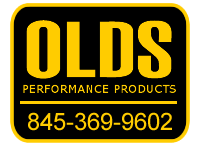Choosing the correct ring for the application is crucial. As a professional engine builder I would consider this to be one of the most complex areas of the entire engine build and it ranks very close to choosing the correct camshaft profile, which I would categorize as being the most important. The wrong ring combination, material, and radial wall tension could either create catastrophe or can yield substantial power gains in an engine. Ring choices are application specific and to determine the correct ring package that would be right for your engine, would entail having a complete understanding of the engine you plan to build, or are building. Below is a small list of applications, and depending on the application at hand, would determine the ring choice that best is suited for that application. The right choice will yield the maximum benefits with out sacrificing mechanical reliability, it will actually increase the engines mechanical reliability. The incorrect ring combination could either contribute to excessive drag which would produce additional load on the reciprocating assembly, and additional load could cause an engine to prematurely fail do to excessive cylinder wall heat, heat absorbtion in the pistons, and stress on the lower end. These Olds engines are temperamental when using factory crankshafts and the ring choice is crucial. Too loose of a radial wall tension ring, especially in the oil ring rails and its expander, could cause oil contamination in the chamber, detonation and oiling out that exhaust port will occur. Oiling an exhaust port will hurt exhaust flow. A bore is a bore is a bore, and choosing that correct package takes many years of understanding on what works and what does not. Have a professional engine builder help you with your choice of rings for your application. Have a professional engine builder help you design the piston so that it can accommodate the correct ring package for your application. There are substantial gains in HP, torque, longevity and mechanical reliability when it comes to the correct ring choice. Gains of over 25 to 30 hp can be found when using the correct ring package. 80 percent of an engines power is lost in the reciprocating assembly and by making the correct choices you can limit your hp losses. The myth, a lighter ring package will not last as long as a heavier one. This is completely untrue. The lighter ring packages will out last, out perform and be mechanically better for the application than a conventional heavy weight ring package. The key is understanding how light you can go, and most engine builders do not have a clue, so they use standard tension rings with the motto, better be safe than sorry. Again too much tension can create mechanical failure and premature engine life expectancy. How do you measure or know what ring is correct or incorrect? This is the art form, it is by feel and it is almost impossible to explain. Over the years and in working with many bores and many different applications, I learned exactly what package would work the best for a given bore size and application, again, one of the most complex items to understand in engine building. I can guarantee you this, and that is, if you can purchase a ring package through a mail order house chances are is that it will be incorrect for your application, not in bore size but in radial wall tension. Be very cautious, there are many ring companies that box there rings and classify them incorrectly. Buyer beware. Here is a list of just a few applications, normally aspirated no vacuum pump bores 4.0 to 4.280, normally aspirated vacuum pump 4.0 to 4.280, normally aspirated dry sump 4.0 to 4.280, The same as above with bores 4.350 – 4.500, the same as above with 4.560-4.700, the same as above with bores greater than 4.700. The same as above with aluminum blocks vs. iron blocks. Injected alky. Blown injected alky. Turbocharged. Nitrous Oxide. All different applications that would determine different styles of rings, radial wall tensions, and bore finishes. To some this will help, to others this will be confusing. No one said engine building is easy and learned over night. I have over 21 years in doing this and you learn something new every day.
Author: paul
Remote Filters Extended Lines 02/06/05
We often see this and think to our selves how cool would that be to have one or two filters hanging from the fire wall or inner fender of our engine compartment. Not only does it look racy, it seems to be the hot lick, and since I have a hopped up engine I must also have those extended braided lines and filters hanging from that trick filter adapter. Right? Wrong, and here is why it is not a good idea unless completely necessary. The oil pumps offered to the Olds enthusiasts are limited, and when you really think about it there is only one internal oil pump available that fits these factory style steel performance and non performance oil pans. Custom oil pumps are available but due not pertain to your average Olds enthusiast, and their costly. Lets take a look at the factory internals, the length of the oil passages, and the size of the oil passages from the main cap where that oil pump bolts on to, and the first main bearing that the oil hits. The oil pump after the two spur gears in the oil pump sends oil through the fifth main cap passage and runs horizontally through the block, exiting out the side and into the factory oil filter adapter. This passage or run to the adapter is about six inches long, and from there it cycles through the oil filter and then back into the block for another six inches until it hits the fifth main bearing. So to wrap up an understanding, you have about 12 inches of run or what is known as an oil passage. Since the oil pump is what we call a common and really not adjustable in its volume, than by increasing the run or passage in length and size you are actually taxing that oil pumps ability to perform properly. The increased weight of the oil due to the braided line extensions and the volume of oil that it now will carry, is what will hinder the oil pumps ability to flow volume and pressure, and by doing this you are greatly reducing the mechanical reliability of your engines life. In most applications where line extensions and remote filters are used, that volume of oil weight against the pump gears and relief has increased by over 300 percent. This is not a good thing at all, and nor is it recommended unless you change the complete design of the oil pump and its engineering to offset the additional volume and weight that you now have placed on it. Even though it might look cool, think twice about what you are doing to your engine and the well being of it. The only time to extend lines off the factory engine block pad is if you have no room what so ever to get your custom or conventional headers in, and at that point I would insist that you stress to your header builder, that the factory oil filter adapter must stay in place and to please build around it. Oldsmobile Performance Products offers a variety of special re-usable high flow aluminum cartridge filters, that in almost all cases will fit and work properly with your factory block adapter, and tightest of headers.
Oil, and Just The Right Amount 7-12-04
There is some great confusion in this area, the proper oil level and how it is determined. Unfortunately the only source of information or guidelines are right in the manufactures descriptions and in most cases advertised incorrectly. Just because a manufacture rates their oil pans at 7, 8 or 9 quarts does not mean that the user should run 7, 8 or 9 quarts in it. The oil pan rating in the description is intended to show the capacity of how large the pan is. This method of advertising is easier than listing the dimensions of the exact pan being sold, although very misleading in a guide as to the capacity or the amount of oil to install in that pan. Deeper than stock depth, or larger capacity oil pans are intended to add additional space between the oil level as it sits in the pan, and the crankshaft. By increasing that space you are assisting the engine in two critical areas. The first would be to reduce windage, which is the tornado effect of air getting thrown down into the top of the oil as it sits in the pan when the crankshaft is turning. Windage will create a disturbance in the oil and churn it or froth it, and the further the oil sits in relation to the crankshaft the less windage it will see. The second area of concern is the reduction of air space in the engine. Not only does your engine get effected by windage from too much oil, but it also gets effected by the reduction of the cubic inches of air space in your engines crankcase, when the oil level is to high. Your engine always produces crankcase pressure (air getting by the rings during its compression cycle) regardless and it is up to you to give this air that is passing by the rings a place to go. By running too much oil your reducing cubic inches of air space, and by doing so your putting additional stress on the engines gaskets. Excessive crankcase pressure which is usually caused by too much oil is the most common cause of oil leaks at the rear main seal, oil pan gaskets, and valve cover gaskets. It is also not uncommon for these Olds engines to blow the dip stick up and release the pressure which causes oil to spray onto your engine compartment and down the side of your engine (most mistake this for a valve cover gasket of leaky oil filter or housing gasket). By running the correct amount of oil in your pan will enhance horsepower, torque and reduce oil leaks. Horsepower and torque is enhanced because the pressure is reduced in the crankcase and is also reduced on the under side of the pistons allowing the engines reciprocating assembly (crank, rods pistons and rings) to accelerate faster. The ultimate goal is to keep your oil pumps pick up safely covered and that usually means no more than 5.5 to 6 quarts total (includes large conventional oil filter) for a pan with a sump area in it such as the Moroso or Milodon 8 and 9 inch deep pans. Flat bottom non-sump pans are application specific and not intended for all applications even if you have the room for it.
Oil mods, not just for performance 7/22/04
Oldsmobile big blocks, unlike the Chevrolets have over 13 feet of bearing material that needs to be covered at all times. Modifications to even a stock rebuild will ensure that your engine is mechanically stable under any type of situation. It is important to understand that oil is not only a means to lubricate the engine components but it is also a means to keep those engine components cool. Keeping the engine components cool is done by allowing the oil to flow through those clearances at a rapid pace with no restrictions what so ever. It is also important to understand, what goes up must come down. Oil is pushed through force by the oil pump resulting in pressure which feeds oil first through the oil filter and then back into the block towards the main bearings, rod bearings as well as filling the two oil gallerys that individual feed each lifter bore, up through the lifters and out the pushrods which oil the springs and rocker arms. It is important to have an oil filter that first and foremost will allow oil to pass through its element without restriction, yet still catch particles of debris if necessary. Buyer beware, not necessarily is the brands of filters that you see advertised the best for your engine. Results have actually shown that the oil filters advertised the most are actually the ones that have been sighted often for their inconsistencies in the construction of their paper element inside, inconsistencies that can leed to blockage or the restriction of oil which prohibits pressure and flow. I am not to fond of the color orange if you know what I mean. Bearing clearances are the most important part of the engine. How there set will determine the life expectancy of your engine. I have never seen an engine fail with clearances that are looser than what these factory manuals and other manuals written by uneducated authors illustrate. The authors probably never have seen the insides of an engine in their life, let alone speak about what is correct and what is incorrect for an Oldsmobile performance engine. You can view my specification guide to clearances in the tech article section which will be coming soon. The correct clearances will allow oil to flow rapidly through the bearings acting as a cooling agent and protecting those internal parts. Engine Bearing clearances that are too tight are a recipe for disaster and engine bearing clearances that are too tight combined with heavy weight viscosity oils such as a 20 50 is even worse. Pressure is not where it is at people, it is volume. Do not be so caught up in pressure. Pressure is a measurement of restriction combined with force. High pressures dictate a restriction and that is not what you want. You want your oil pressure gauge to be responsive as your engines rpms increase. You want that oil pressure gauge to sweep and respond with engine rpm. Just to give you a for instance, an NHRA pro stock engine that is 500 cubic inches and produces in excess of 1300 hp and 800 plus foot pounds of torque, idles with oil pressures between 8 and 12 psi and when it reaches its maximum rpm which is about 9600 it only achieves 48 to 52 pounds of oil pressure. These are high rpm, high load and high stress racing engines and they must perform with out failure time and time again. What goes up must come down. This is one of the largest faults or inherent problems with an Olds engine, oil restrictions which do not permit oil to flow freely down from the heads to the pan fast enough. Modifications must be made to enlarge the four oil passage areas in the block where the oil travels down through the head gaskets and down the back and front of the block in the lifter valley area. These 4 small holes are part of the deck surface area on most big block Olds engines. I would recommend to actually carve them clean out of the block and polish that area. I also enlarge the front and back drain holes in the heads as well. I do recommend an oil viscosity that will flow well through the bearing clearances and allow for good drain back. A 10 30 for the cooler months and a maximum viscosity of a 10 40 for the hotter summer months.
Compression Ratio. The right choice for you. 12/23/07
Besides shear cubic inches, compression ratio has just about the greatest impact on the ability for an engine to produce torque output and horsepower. The higher the ratio the more horsepower the engine will produce, to a certain extent. In years of research we have found that these Oldsmobile engines will continue to make torque and hp with compression ratios that well exceed 12 to 1. The increase of compression ratio will allow the engine and its cylinders to absorb more cubic feet per minute of air and fuel. It will also condense that air fuel mixture greater than an engine with lower compression ratios. The effects during combustion are greatly enhanced producing more torque output and hp than an identical engine with a lower compression ratio. Unfortunately the highest possible ratio is not necessarily for everyone and with the pump gas available today, it is a smart idea to make sure that the compression ratio of choice is matched accordingly. An engine that has compression ratios that exceed today’s pump gas values (octane and content) will encounter problems such as detonation. Detonation will destroy an engine and just because it is not heard does not mean that it is not prevalent and doing damage in your engine. Detonation from elevated compression ratios and pump gas will destroy your engine parts. Your piston rings will be the first to go and the ability to seal those cylinders will be at risk. A cylinder that is not sealed up will be subject to engine oil, which will get past those rings and into the combustion chamber of your cylinder head. Oil burned in the chamber will cause detonation as well. Your engine parts such as wrist pins rod bearings and main bearings will also suffer from increased loads, harmonics and shock caused by detonation. If you want your investment to last, this is the area of concern and it should not be taken lightly when making a decision. The ability to mix pump gas with race fuel offers some great advantages for those who might not want the added cost of straight race fuel. The race fuel has components within that aid and prevent vaporization of pump gas fuel when mixed. Leaded race fuel mixed with pump gas also has its advantages. Lead introduced into the engine will cushion the shock in the chamber, as well as prevent vaporization. Mixing race fuel with pump gas allows for increased compression ratios so you can obtain more torque output and horsepower safely. Even the slightest mix such as a 10 percent addition to your pump gas will allow for increased compression ratios that could add 40 to 60 horsepower to your engines output. Regardless of your choice of compression ratio, you should always run your engine at the coolest operating temperatures possible. The cooler the engine the less prone it is to detonation and the more torque output and hp it will make, not to mention that your engine parts will live longer. To sum this up, I would recommend that you look over your budget and make a decision based upon what you can afford for fuel. Once committed than stay committed to that fuel or ratio mix. If you need further assistance in understanding what compression ratio might be suitable for your budget and horsepower expectations, than you can consult with us. Our email address is listed in the customer care section of our web site.
Camshafts 8 01 12
The mis-conception about camshafts and what they can and can’t do. I am sure all of you have heard this time and time again that a camshaft can alter where the power band comes in on an engine. As much as we would like to believe this, it is not necessarily the truth. There are some key factors in where the power range will come in. Those key factors really have to do with the size of the engine (cubic inch), the static compression, piston speed and the volume from the intake valve seat area all the way back up to the venturi of the carburetor. Piston speed is understood from rod ratio and engine rpm. Manipulating these areas will have a significant greater impact as to where the power comes in and how broad it will be, than the camshaft profile itself. The camshaft serves many different functions and each and every function that it provides must accent those areas discussed above. The first area of discussion is cylinder pressure. The intake lobe profile will dictate exactly when and where that intake valve opens and exactly when and where that intake valve will close. All of this being done while the crankshaft is in motion, operating that piston up and down the bore, which allows air and fuel to enter. The closure of that intake valve will trap that same air and fuel to be compressed. I can’t express how critical it is to have those events correct, and the lobe separation (LSA, lobe separation angle), in conjunction with the camshafts duration and the intake lobes centerline install will dictate the cylinder pressure of your engine. The wrong choice and you will have excessive cylinder pressures or weak cylinder pressure. Excessive pressure will do damage resulting in excessive force onto the wrist pin, bearings and crankshaft. Excessive cylinder pressures lead to detonation. Lack of cylinder pressure will leave the engine with a rich condition from the inability to shear the fuel as it enters the manifold. The carburetors idle circuit will suffer as well due to the weak signal from poor air speed. I like to look at camshafts as the mechanism that operates the timing events on the front and back door. The object is to get those events correct. We just spoke about our front door operation and now it’s onto the back door and how long we should hold it open. The best way that I can express to my customers how a camshaft operates, when exhausting what has been burned, is to give an example such as a business establishment. Let’s say we are operating a business, whereas we have a line up at our front door and our establishment holds occupancy of 500. It is important to have minimum of the same size exit door at the least, and that exit doors events will be our exhaust, and how far off we set our exhaust durations apart from our intake durations. The more efficient our back door is, the more customers we can get in that front door. The exhaust lobe profile in my estimation is just as important, if not more important than the intake profile. By creating the perfect exhaust profile we can get rid of 100 percent of the burned and unburned combustion. This allows for the combustion chamber and area above the piston, to be left with a vacuum. The inability to get rid of that exhaust will create reversion. Reversion is the passage of air/fuel reversing and going in the wrong direction. With the correct exhaust profile you can create exhaust speed, and that exhaust speed will allow for a complete scavenge of the engines contaminants. The complete scavenge will leave a vacuum, and that vacuum will allow for the charge to be taken in from the intake side, even without the movement of the piston. Think of that exhaust and its speed, as drafting of which is used frequently in nascar. If you pull your vehicle up close enough to another vehicle while at great speed, that vehicle behind will be effortlessly moving with little to no restriction. A vortex or vacuum In other words. We are using the exhaust speed to help assist that intake charge. We call this Inertia ramming. The key to camshaft design is to understand the pump and the functions of that pump and to match the camshaft events accordingly. If you need assistance with a camshaft design that would suit your engines application correctly, please feel free to email or call. Thank you
Adkins and Rizzi 1970 W-30 442
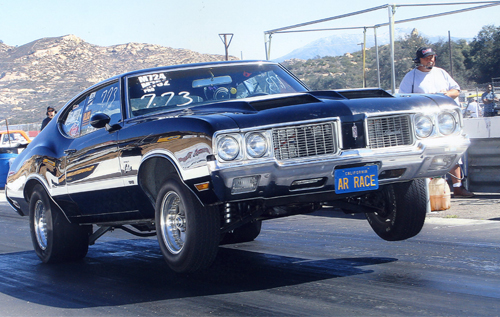

seen here at Borona dragway in California. One of the many team cars that Art Rizzi and Joe Adkins campains out on the west coast. The power under the hood comes from a 356 cubic inch pump gas budget small block powered Olds engine. This W-30 is a solid 11 second player. Adkins and Rizzis rides are powered up with many parts and accesories from Olds Performance Products.
Andy Miller’s 8 second Cutlass
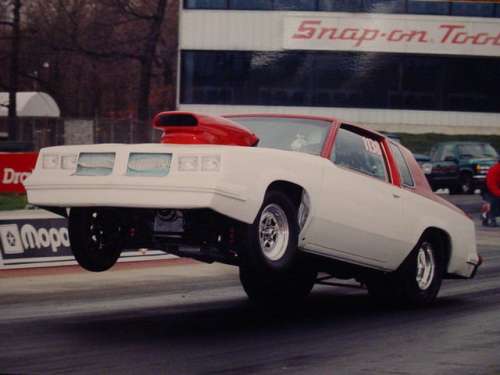
One of the quickest and fastest normally aspirated small blocks in the world. This 86 cutlass was powered by a 416 cubic inch engine with a single 750 carb. At 3185 pounds this ride layed down 1.19 60fts with et figures in the 8.70 range at over 153mph
Awesome
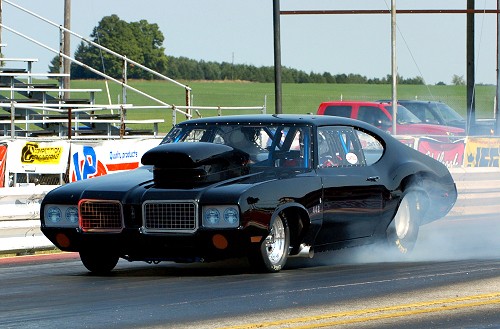
would be the only word to describe John Waidelichs beautiful 70 442. Johns power comes from a normally aspirated big block Batten headed Olds engine. Johns puts his trust in Olds Performance Products when it comes to engine design. From the camshaft down to the to the reciprocating assembly. At a tic under 3000 pounds, Johns ride is one of the fastest around. Do not miss seeing Johns ride rocket into the 8 second range.
Bill Puruckers 69
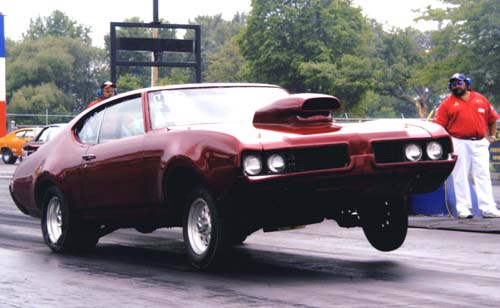

Cutlass seen here at Norwalk, OH. Bill has teamed up with Olds Performance Products this season and will be campaining a new plant under the hood of his 69. Bills 490 inch stroker design will be equiped with many of the components here on our site. Bill will be incorporating our custom offset ground stroker crank, GRP rods, CP pistons, Performance ring package, Billet timing set and many many more items seen here in our on line catalog. Andy Miller will be personally assiting Bill with his engine program and tune up. Expect this car to be seen making a statement at Norwalk this year.
